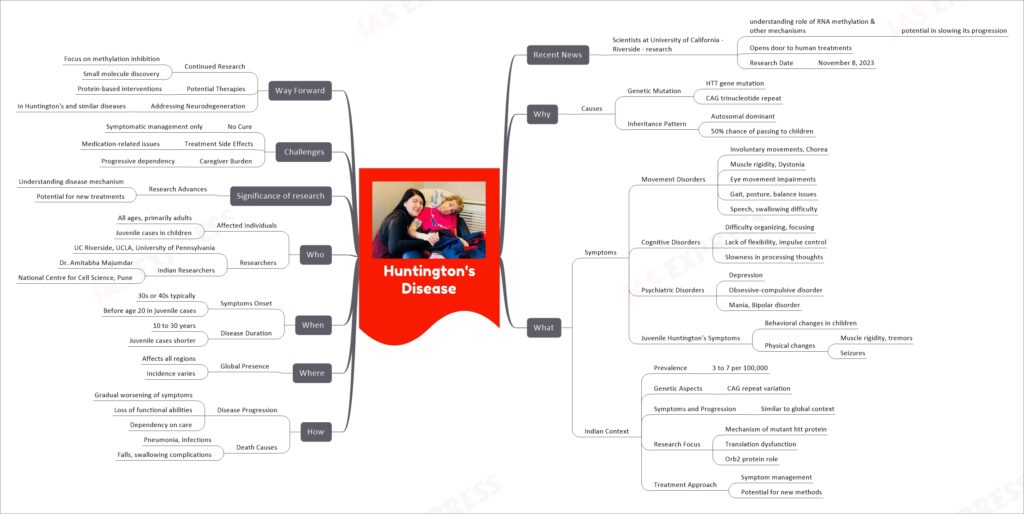Huntington’s Disease: Causes, Symptoms, Treatment
Simplified Explanation
Huntington’s disease is a rare, inherited disorder that causes the progressive breakdown of nerve cells in the brain, leading to movement, cognitive, and psychiatric disorders. Recent research has shown potential in slowing its progression through understanding the genetic mechanisms involved, particularly focusing on the role of RNA methylation. There’s no cure, but treatments focus on managing symptoms. The disease typically manifests in the 30s or 40s, with a juvenile form appearing earlier. It’s caused by a genetic mutation in the HTT gene, following an autosomal dominant inheritance pattern. In India, the disease affects 3 to 7 people per 100,000, with research focusing on mutant huntingtin protein and potential new treatments.
Comprehensive Explanation
Introduction
In the world of medical science, a ray of hope has emerged for those battling Huntington’s Disease. Recent research conducted by scientists at the University of California – Riverside has shed light on promising developments in the understanding and potential treatment of this devastating neurodegenerative disorder. This article will explore the causes, symptoms, impact, and potential therapies for Huntington’s Disease, as well as the challenges it presents.
What is Huntington’s Disease?
Huntington’s Disease is a hereditary neurological disorder that causes progressive degeneration of nerve cells in the brain. It is characterized by a range of physical, cognitive, and psychiatric symptoms. Key aspects of the disease include:
- Genetic Mutation: Caused by a mutation in the HTT gene, characterized by a CAG trinucleotide repeat.
- Inheritance Pattern: Autosomal dominant, with a 50% chance of passing the mutated gene to offspring.
Symptoms of Huntington’s Disease
The disease manifests through a variety of symptoms, affecting different aspects of an individual’s life:
- Movement Disorders: Involuntary movements, muscle rigidity, eye movement impairments, and difficulties with gait, posture, and balance.
- Cognitive Disorders: Impaired organization and focus, lack of flexibility, and slowness in processing thoughts.
- Psychiatric Disorders: Depression, obsessive-compulsive disorder, mania, and bipolar disorder.
- Juvenile Huntington’s Symptoms: Behavioral changes in children, accompanied by physical symptoms such as muscle rigidity, tremors, and seizures.
Huntington’s Disease in the Indian Context
- Prevalence: Estimated at 3 to 7 cases per 100,000 individuals in India.
- Genetic Aspects: CAG repeat variation is consistent with global patterns.
- Symptoms and Progression: Similar to the global context.
- Research Focus: Investigating the mechanism of the mutant htt protein, translation dysfunction, and the role of the Orb2 protein.
- Treatment Approach: Primarily focused on symptom management with potential for new methods.
How Does Huntington’s Disease Progress?
- Disease Progression: Symptoms worsen gradually, leading to a loss of functional abilities and increasing dependency on care.
- Causes of Death: Often attributed to pneumonia, infections, falls, and swallowing complications.
Where and When Does Huntington’s Disease Occur?
- Global Presence: Huntington’s Disease affects individuals in all regions, with varying incidence rates.
- Symptoms Onset: Typically in a person’s 30s or 40s, but can occur before age 20 in juvenile cases.
- Disease Duration: Can span from 10 to 30 years, with juvenile cases having a shorter duration.
Who is Affected by Huntington’s Disease?
- Affected Individuals: The disease can affect individuals of all ages, primarily adults, with juvenile cases impacting children.
- Researchers: Pioneering research is conducted by institutions such as UC Riverside, UCLA, University of Pennsylvania, and Indian researchers like Dr. Amitabha Majumdar at the National Centre for Cell Science in Pune.
Significance of Huntington’s Disease Research
- Research Advances: Progress in understanding the disease mechanism offers hope for potential new treatments.
Challenges and the Way Forward
- No Cure: Currently, there is no cure for Huntington’s Disease, and management primarily focuses on symptom control.
- Treatment Side Effects: Medications may have related issues.
- Caregiver Burden: Caregivers often face increasing challenges due to the progressive nature of the disease.
The Way Forward
- Continued Research: Ongoing exploration of methylation inhibition and the discovery of small molecules.
- Potential Therapies: Consideration of protein-based interventions.
- Addressing Neurodegeneration: Not only in Huntington’s Disease but also in similar neurodegenerative disorders like ALS and Spinocerebellar Ataxia.
Conclusion
The recent breakthroughs in Huntington’s Disease research offer a glimmer of hope to those affected by this devastating condition. While challenges remain, the dedication of researchers and advancements in understanding the disease mechanism bring us closer to potential therapies. As we continue to explore the intricacies of Huntington’s Disease, we remain committed to finding ways to alleviate the suffering of those afflicted by this relentless neurodegenerative disorder.
If you like this post, please share your feedback in the comments section below so that we will upload more posts like this.


